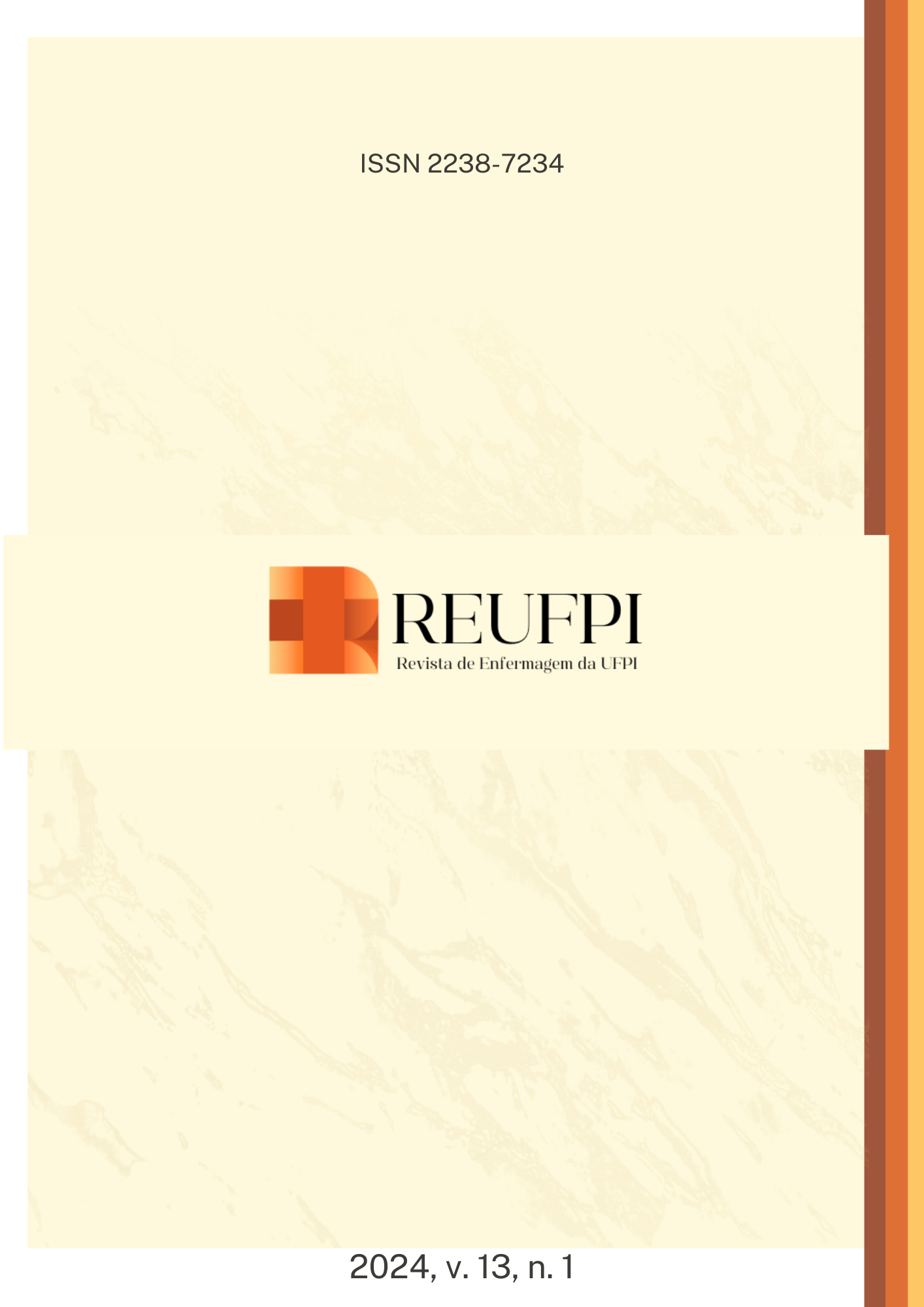Perfil epidemiológico de pacientes com neoplasia prostática em um centro assistência de alta complexidade em oncologia
DOI:
https://doi.org/10.26694/reufpi.v13i1.5112Keywords:
Medical Oncology, Prostatic Neoplasms, Epidemiology, Men's Health, Hospital RecordsAbstract
Objective: To describe the profile of prostate cancer patients who sought hospital care at a Brazilian High Complexity Oncology Center, as well as their condition on arrival at the center. Methods: This is a descriptive observational study, based on secondary data from the tumor file in the Hospital Cancer Registry at Afecc-Hospital Santa Rita de Cássia. RStudio and R software were used for descriptive analysis. Results: A total of 5,403 new analytical and non-analytical cases of prostate neoplasms were analyzed between 2000 and 2016. The number of cases had a mean age of 69.40 years (SD=8.82), with an increasing trend over the period (p<0.001). The majority of patients were over 60 years old (86.82%), brown or white (91.97%), with incomplete primary education (52.88%), married (67.37%), referred by SUS (76.12%), with no other primary tumors (97.87%), and histological type classified as adenocarcinoma (96.22%). The variables age (p=0.017), race/skin color (p<0.001) and education (p<0.001) showed statistically significant differences between analytical and non-analytical cases. Conclusion: The analyses show an upward trend in the incidence of prostate cancer over the years, and prostate neoplasia has a tropism for older, married men with a low education level.
References
World Health Organization. Health Statistics and Information Systems: Disease Burden and Mortality Estimates; WHO: Geneva, Switzerland, 2023.
Siegel RL, Miller KD, Wagle NS, Jemal A. Cancer statistics, 2023. CA Cancer J Clin. 2023 Jan;73(1):17-48. doi: 10.3322/caac.21763.
Lopes-Júnior LC, Lima RAG. Cancer care and interdisciplinary practice. Cad Saude Publica. 2019;35(1):e00193218. doi: 10.1590/0102-311x00193218.
Brazil. José Alencar Gomes da Silva National Cancer Institute. Coordenação de Prevenção e Vigilância. Estimativa 2023: Incidência do Câncer no Brasil. 2022. Available in: https://www.inca.gov.br/publicacoes/livros/estimativa-2023-incidencia-de-cancer-no-brasil
Rawla P. Epidemiology of Prostate Cancer. World J Oncol. 2019 Apr;10(2):63-89. doi: 10.14740/wjon1191.
Sung H, Ferlay J, Siegel RL, Laversanne M, Soerjomataram I, Jemal A, et al. Global Cancer Statistics 2020: GLOBOCAN Estimates of Incidence and Mortality Worldwide for 36 Cancers in 185 Countries. CA Cancer J Clin. 2021 May;71(3):209-249. doi: 10.3322/caac.21660.
Brazil. José Alencar Gomes da Silva National Cancer Institute. Coordenação de Prevenção e Vigilância. Estimativa 2020: Incidência de Câncer no Brasil. 2019; 120p. Available from: https://www.inca.gov.br/sites/ufu.sti.inca.local/files/media/document/estimativa-2020-incidencia-de-cancer-no-brasil.pdf
Zhai Z, Zheng Y, Li N, Deng Y, Zhou L, Tian T, et al. Incidence and disease burden of prostate cancer from 1990 to 2017: Results from the Global Burden of Disease Study 2017. Cancer. 2020 Jan 1;126(9):1969-1978. doi: 10.1002/cncr.32733.
Zacchi SR, Amorim MHC, Souza MAC, Miotto MHMB, Zandonade E. Associação de variáveis sociodemográficas e clínicas com o estadiamento inicial em homens com câncer de próstata. Cad. Saúde Colet 2014; 22(1):93-100.
Lopes-Júnior LC, Dell'Antonio LS, Pessanha RM, Dell'Antonio CS, da Silva MI, de Souza TM, et al. Completeness and Consistency of Epidemiological Variables from Hospital-Based Cancer Registries in a Brazilian State. Int J Environ Res Public Health. 2022 Sep 22;19(19):12003. doi: 10.3390/ijerph191912003.
Grippa WR, Dell'Antonio LS, Salaroli LB, Lopes-Júnior LC. Incompleteness trends of epidemiological variables in a Brazilian high complexity cancer registry: An ecological time series study. Medicine (Baltimore). 2023 Aug 4;102(31):e34369. doi: 10.1097/MD.0000000000034369.
Pereira LD, Schuab SIPC, Pessanha RM et al. Neoplasias malignas e a importância dos registros de câncer. In Políticas, Epidemiologia e Experiências no Sistema Único de Saúde (SUS)–Possibilidades e desafios do Cenário Brasileiro, 1st ed.; Silva Junior FJG, Sales JCS, Galiza FT, Monteiro CFS, Eds.; Editora CRV: Curitiba, Brazil, 2020; Volume 1, Chapter 21, pp. 267–281.
Secretaria do Estado do Espírito Santo (SESA). Secretaria do Estado do Espírito Santo. Informativo Vigilância do Câncer. Gerência Estratégica de Vigilância em Saúde (GEVS). Núcleo Especial de Vigilância Epidemiológica (Neve) Doenças e Agravos Não Transmissíveis (DANT`s). Vigilância do Câncer. Coordenação Estadual dos Registros de Câncer do estado do Espírito Santo. 2017.
Brazil. National Cancer Institute. Registros Hospitalares de Câncer: Planejamento e Gestão/Instituto Nacional de Câncer, 2ª ed.; INCA: Rio de Janeiro, Brasil, 2010; 536p. Available from: https://www.inca.gov.br/sites/ufu.sti.inca.local/files//media/document//registros-hospitalares-de-cancer-2010.pdf
Hollander M, Wolfe DA. Nonparametric Statistical Methods. New York: John Wiley & Sons. 1973:139–146.
Kendall MG. Rank correlation methods. London: Griffin; 1975.
Bell KJ, Del Mar C, Wright G, Dickinson J, Glasziou P. Prevalence of incidental prostate cancer: A systematic review of autopsy studies. Int J Cancer. 2015 Oct 1;137(7):1749-57. doi: 10.1002/ijc.29538.
Braga SFM, Silva RPD, Guerra Junior AA, Cherchiglia ML. Prostate Cancer Survival and Mortality according to a 13-year retrospective cohort study in Brazil: Competing-Risk Analysis. Rev Bras Epidemiol. 2021 Jan 6;24:e210006. doi: 10.1590/1980-549720210006.
Wu D, Yang Y, Jiang M, Yao R. Competing risk of the specific mortality among Asian-American patients with prostate cancer: a surveillance, epidemiology, and end results analysis. BMC Urol. 2022 Mar 24;22(1):42. doi: 10.1186/s12894-022-00992-y.
Giaquinto AN, Miller KD, Tossas KY, Winn RA, Jemal A, Siegel RL. Cancer statistics for African American/Black People 2022. CA Cancer J Clin. 2022 May;72(3):202-229. doi: 10.3322/caac.21718.
Pettersson A, Robinson D, Garmo H, Holmberg L, Stattin P. Age at diagnosis and prostate cancer treatment and prognosis: a population-based cohort study. Ann Oncol. 2018 Feb 1;29(2):377-385. doi: 10.1093/annonc/mdx742.
Lima MAN, Villela DAM. Sociodemographic and clinical factors associated with time to treatment for colorectal cancer in Brazil, 2006-2015. Cad Saude Publica. 2021 May 28;37(5):e00214919. doi: 10.1590/0102-311X00214919.
Zarcos-Pedrinaci I, Fernández-López A, Téllez T, Rivas-Ruiz F, Rueda A, Morales Suarez-Varela MM, et al. CARESS-CCR Study Group. Factors that influence treatment delay in patients with colorectal cancer. Oncotarget. 2017 May 30;8(22):36728-36742. doi: 10.18632/oncotarget.13574.
Bhatia A, Victora CG, Beckfield J, Budukh A, Krieger N. "Registries are not only a tool for data collection, they are for action": Cancer registration and gaps in data for health equity in six population-based registries in India. Int J Cancer. 2021 May 1;148(9):2171-2183. doi: 10.1002/ijc.33391.
Hong X, Cao S, Chi Z, Zhang Y, Lin T, Zhang Y. Influencing factors for mortality in prostate cancer patients with T1 and T2 stage: a retrospective cohort study. Transl Androl Urol. 2023 Jan 30;12(1):58-70. doi: 10.21037/tau-22-818.
Darré T, Folligan KU, Kpatcha TM, Kanassoua K, Sewa E, Daré S, et al. Evolution of the Histo-Epidemiological Profile of Urological Cancers in Togo. Asian Pac J Cancer Prev. 2017 Feb 1;18(2):491-494. doi: 10.22034/APJCP.2017.18.2.491.
Braga SFM, Souza MC, Oliveira RR, Andrade EIG, Acurcio FA, Cherchiglia ML. Patient survival and risk of death after prostate cancer treatment in the Brazilian Unified Health System. Rev Saude Publica. 2017 May 15;51(0):46. doi: 10.1590/S1518-8787.2017051006766.
Cole AP, Herzog P, Iyer HS, Marchese M, Mahal BA, Lipsitz SR, et al. Racial differences in the treatment and outcomes for prostate cancer in Massachusetts. Cancer. 2021 Aug 1;127(15):2714-2723. doi: 10.1002/cncr.33564.
Sacramento RS, Simião LJ, Viana KCG, Andrade MAC, Amorim MHC, Zandonade E. Association of sociodemographic and clinical variables with time to start prostate cancer treatment. Cien Saude Colet. 2019 Sep 9;24(9):3265-3274.
Grippa WR, Pessanha RM, DellÁntonio LS, DellÁntonio CS, Salaroli LB, Lopes-Júnior LC. Completeness of variables in Hospital-Based Cancer Registries for prostatic malignant neoplasm. Rev Bras Enferm. 2024;76(3):xx-xx. doi: http://dx.doi.org/10.1590/0034-7167-xx. Ahead of print.
Sue-Ling HM, Johnston D, Martin IG, Dixon MF, Lansdown MR, McMahon MJ, et al. Gastric cancer: a curable disease in Britain. BMJ. 1993 Sep 4;307(6904):591-6. doi: 10.1136/bmj.307.6904.591.
Downloads
Published
How to Cite
Issue
Section
License
Copyright (c) 2024 Rev Enferm UFPI

This work is licensed under a Creative Commons Attribution 4.0 International License.
Autores mantém os direitos autorais e concedem à REUFPI o direito de primeira publicação, com o trabalho licenciado sob a Licença Creative Commons Attibution BY 4.0 que permite o compartilhamento do trabalho com reconhecimento da autoria e publicação inicial nesta revista.






